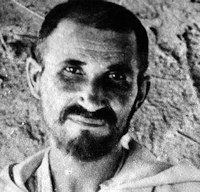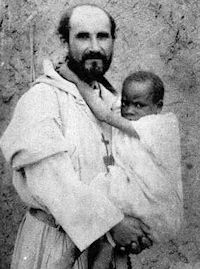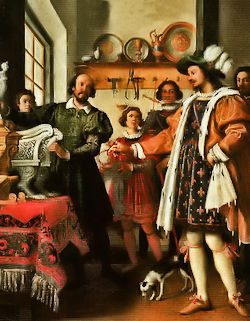Advent: December 1st
Thursday of the First Week of Advent
Other Commemorations: St. Charles Eugène de Foucauld, Priest (RM); St. Eligius, Bishop (RM)
Free eBook:

|
| Free eBook: Liturgical Year 2023-2024, Vol. 4 |
» Enjoy our Liturgical Seasons series of e-books!
And God seeing that the wickedness of men was great on the earth, and that all the thought of their heart was bent upon evil at all times, It repented him that he had made man on the earth. And being touched inwardly with sorrow of heart, He said: I will destroy man, whom I have created, from the face of the earth, from man even to beasts, from the creeping thing even to the fowls of the air, for it repenteth me that I have made them.
Historically today is the feast of St. Edmund Campion, Jesuit martyr, one of the Forty Martyrs of England and Wales, also called "the Pope's Champion".
St. Charles de Foucauld (Brother Charles of Jesus)
 Saint Charles de Foucauld was born in Strasbourg, France on September 15th, 1858. Orphaned at the age of six, he and his sister Marie were raised by their grandfather in whose footsteps he followed by taking up a military career.
Saint Charles de Foucauld was born in Strasbourg, France on September 15th, 1858. Orphaned at the age of six, he and his sister Marie were raised by their grandfather in whose footsteps he followed by taking up a military career.
He lost his faith as an adolescent. His taste for easy living was well known to all and yet he showed that he could be strong willed and constant in difficult situations. He undertook a risky exploration of Morocco (1883-1884). Seeing the way Muslims expressed their faith questioned him and he began repeating, “My God, if you exist, let me come to know you.”
On his return to France, the warm, respectful welcome he received from his deeply Christian family made him continue his search. Under the guidance of Fr. Huvelin he rediscovered God in October 1886. He was then 28 years old. “As soon as I believed in God, I understood that I could not do otherwise than to live for him alone.”
 A pilgrimage to the Holy Land revealed his vocation to him: to follow Jesus in his life at Nazareth. He spent 7 years as a Trappist, first in France and then at Akbès in Syria. Later he began to lead a life of prayer and adoration, alone, near a convent of Poor Clares in Nazareth.
A pilgrimage to the Holy Land revealed his vocation to him: to follow Jesus in his life at Nazareth. He spent 7 years as a Trappist, first in France and then at Akbès in Syria. Later he began to lead a life of prayer and adoration, alone, near a convent of Poor Clares in Nazareth.
Ordained a priest at 43 (1901) he left for the Sahara, living at first in Beni Abbès and later at Tamanrasset among the Tuaregs of the Hoggar. He wanted to be among those who were, “the furthest removed, the most abandoned.” He wanted all who drew close to him to find in him a brother, “a universal brother.” In a great respect for the culture and faith of those among whom he lived, his desire was to “shout the Gospel with his life”. “I would like to be sufficiently good that people would say, “If such is the servant, what must the Master be like?”
On the evening of December 1, 1916, he was killed by a band of marauders who had encircled his house.
He had always dreamed of sharing his vocation with others: after having written several rules for religious life, he came to the conclusion that this “life of Nazareth” could be led by all. Today the “spiritual family of Charles de Foucauld” encompasses several associations of the faithful, religious communities and secular institutes for both lay people and priests.
—Excerpted from the Libreria Editrice Vaticana
Highlights and Things To Do:
- See the website dedicated to St. Charles.
- Read more about St. Charles:
- Here are some quotes by Charles de Foucauld at Jesus Caritas and a picture biography.
- Another excellent biography of Charles de Foucauld which can be downloaded as a pdf file.
- Some short biographies from the Dictionary of African Christian Biography.
St. Eligius
 Eligius, a goldsmith at Paris, was commissioned by King Clotaire to make a throne. With the gold and precious stones given him he made two. Struck by his rare honesty, the king gave him an appointment at court, and demanded an oath of fidelity sworn upon holy relics; but Eligius prayed with tears to be excused, for fear of failing in reverence to the relics of the Saints.
Eligius, a goldsmith at Paris, was commissioned by King Clotaire to make a throne. With the gold and precious stones given him he made two. Struck by his rare honesty, the king gave him an appointment at court, and demanded an oath of fidelity sworn upon holy relics; but Eligius prayed with tears to be excused, for fear of failing in reverence to the relics of the Saints.
On entering the court he fortified himself against its seductions by many austerities and continual ejaculatory prayers. He had a marvellous zeal for the redemption of captives, and for their deliverance would sell his jewels, his food, his clothes, and his very shoes, once by his prayers breaking their chains and opening their prisons. His great delight was in making rich shrines for relics.
His striking virtue caused him, a layman and a goldsmith, to be made Bishop of Noyon, and his sanctity in this holy office was remarkable.
He possessed the gifts of miracles and prophecy, and died in 665.
—Excerpted from Lives of the Saints, by Alban Butler, Benziger Bros. ed. [1894]
Patronage: against boils; against epidemics; against equine diseases; against poverty; against ulcers; agricultural workers; basket makers; blacksmiths; boilermakers; cab drivers; candle makers; carpenters; carriage makers; cartwrights; clock makers; coachmen; computer scientists; craftsmen; cutlers; electricians; engravers; farmers; farriers; gilders; goldsmiths; guards; gunsmiths; harness makers; horse traders; jewelers; jockeys; knife makers; laborers; lamp makers; livestock; locksmiths; mechanics; metalsmiths; miners; minters; numismatics; Royal Electrical and Mechanical Engineers; saddle makers; scissors grinders; security guards; servants; silversmiths; tinsmiths; tool makers; veterinarians; watch makers; wheelwrights; Worshipful Company of Blacksmiths; coin collectors; garages; gas stations; horses; livestock; metal collectors; numismatists; peasants; petrol stations; precious metal collectors; sick horses; Eloois-Vijve, Belgium; Sint-Eloois-Winkel, Belgium; Carrozzieri, Italy; Schinveld, Netherlands (from CatholicSaints.info)
Symbols and Represented As: anvil; hammer; horseshoe; pincers
bishop with a crosier and miniature church of chased gold; bishop with a hammer, anvil, and horseshoe; bishop with a horse; courtier; goldsmith; man grasping a devil‘s nose with pincers; man holding a chalice and goldsmith‘s hammer; man holding a horse‘s leg, which he detached from the horse in order to shoe it more easily; man shoeing a horse; man with hammer and crown near a smithy; man with hammer, anvil, and Saint Anthony; with Saint Godebertha of Noyon; giving a ring to Saint Godebertha (from CatholicSaints.info)
Highlights and Things To Do:
- Read more on St. Eligius:
- St. Eligius' remains are in the Noyon cathedral.
- Geometry plays a role in today's feast day. "Recent studies regarding Fractal patterns and French Gothic Cathedrals constructed from the 12th to 15th century proved new understanding in the design of these Cathedrals. It was determined that not only did Noyon Cathedral and others follow Euclidean Geometry, but also Fractal Geometry and Fractal Dimensions." See The Fractal Pattern of the French Gothic Cathedrals.







